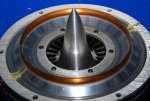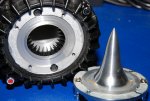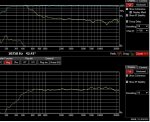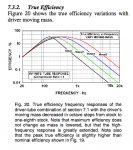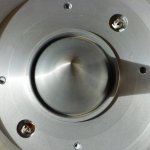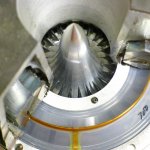New DIY Mid High (90deg) - AKA PM90
- Thread starter Peter Morris
- Start date
You are using an out of date browser. It may not display this or other websites correctly.
You should upgrade or use an alternative browser.
You should upgrade or use an alternative browser.
Re: New DIY Mid High
I'll save you the trouble
The first picture is the LF diaphragm which uses a 90 mm VC, the second is the HF diaphragm, its has the same size, 44 mm VC as the 4550.
Art, ill open one now and take picture for you.
I'll save you the trouble
The first picture is the LF diaphragm which uses a 90 mm VC, the second is the HF diaphragm, its has the same size, 44 mm VC as the 4550.
Attachments
Last edited:
Re: New DIY Mid High
I've been reading through this thread since the beginning and I can't for the life of me find reference to a 4594HE on the BMS site. Maybe I'm not looking in the right place, but I can't even find it using my google-fu. I would be very grateful if someone could point me in the right direction.
I've been reading through this thread since the beginning and I can't for the life of me find reference to a 4594HE on the BMS site. Maybe I'm not looking in the right place, but I can't even find it using my google-fu. I would be very grateful if someone could point me in the right direction.
Re: New DIY Mid High
Yes it uses the same size vc as the 4550 and 4552 but the cone is lot smaller. It goes only toward the outside and is less wide then at the 4550/4552.
Yes it uses the same size vc as the 4550 and 4552 but the cone is lot smaller. It goes only toward the outside and is less wide then at the 4550/4552.
Re: New DIY Mid High
its basically 4594 with the 4592 phase plug so it sticks out. Reportedly it has a bit better high end then the rest. But i am yet to hear one.
its basically 4594 with the 4592 phase plug so it sticks out. Reportedly it has a bit better high end then the rest. But i am yet to hear one.
Re: New DIY Mid High
Yes, but to answer Art’s question, it’s not about area, it’s about volume – diaphragm area multiplied Xmax.
It’s about designing a driver that’s very efficient between 6 KHz and 20 KHz i.e. has a high resonate frequency and can take good amount of power, not Xmax and operate without diaphragm break-up modes above 10 KHz unlike most large format compression drivers including the DH1A.
There is also an advantage on complex signals (music) in having one driver cover the range in this case from 800 Hz to 6.75 Khz and another from 6.75 KHz to 20 KHz. The output is the sum of these two.
http://www.xlrtechs.com/dbkeele.com...Maximum Efficiency of Compression Drivers.pdf
http://www.eighteensound.it/TECHNOLOGIES/TPM
Yes it uses the same size vc as the 4550 and 4552 but the cone is lot smaller. It goes only toward the outside and is less wide then at the 4550/4552.
Yes, but to answer Art’s question, it’s not about area, it’s about volume – diaphragm area multiplied Xmax.
It’s about designing a driver that’s very efficient between 6 KHz and 20 KHz i.e. has a high resonate frequency and can take good amount of power, not Xmax and operate without diaphragm break-up modes above 10 KHz unlike most large format compression drivers including the DH1A.
There is also an advantage on complex signals (music) in having one driver cover the range in this case from 800 Hz to 6.75 Khz and another from 6.75 KHz to 20 KHz. The output is the sum of these two.
http://www.xlrtechs.com/dbkeele.com...Maximum Efficiency of Compression Drivers.pdf
http://www.eighteensound.it/TECHNOLOGIES/TPM
Last edited:
Re: New DIY Mid High
.... and demodulation rings for lower distortion. Its not listed on their web site.
FWIW USSpeakers have the HE version of the 4599 on their website.
http://www.usspeaker.com/bms 4599ndhe-1.htm
its basically 4594 with the 4592 phase plug so it sticks out. Reportedly it has a bit better high end then the rest. But i am yet to hear one.
.... and demodulation rings for lower distortion. Its not listed on their web site.
FWIW USSpeakers have the HE version of the 4599 on their website.
http://www.usspeaker.com/bms 4599ndhe-1.htm
Last edited:
Re: New DIY Mid High
While we probably agree basically, this opinion is not without problems.
Your statement could be interpreted as: there is good and bad usage of DSP
And who is going to judge this? You, me, Tony Andrews?
Where do you draw the line to the "inferior design"
Let's take Peters box as an example:
Using a folded horn for low-mid reproduction up to 800Hz is at least questionable, EV did that 40 years ago ( Eliminator ) and abandoned the concept.
Is this now an inferior design or an acceptable compromise, because it serves his design goal to make the horn loading go lower.
Where we probably will not agree is on crossovers:
Crossovers serve to protect the drivers, integrate the passbands into a system and can help to improve directivity.
This is never an easy task, and good drivers deserve good crossovers, which is always a lot of work ( nothing simple with that ).
Peters attempt to make the crossover simpler is technically inferior to everyone, who can read the phase response,
but serves well to my point, that this BMS driver is not the new Überdriver.
It might be good, but is difficult to handle.
I would really like to see some distortion measurements, comparing the 4594 to the HE version.
Uwe
Uwe
Why would you want to start with a electro-mechanically broken or inferior system to begin with, that is plain crazy?
Unless it is just an exercise in signal processing?
The problem was that many manufactures for a period as DSPs became very popular became heavily reliant on linear processing to flatten the on-axis response instead of spending time on improving transducer designs. All I was saying is that that era seems to finally have come to an end.
As that relates to Peter's design, my comment was simply in reference to how by selecting well behaved components to begin with, he was able to come up with a simpler crossover design which worked well. Perhaps even something which could be implemented from analog components.
All of this has nothing to do with what Klippel and others are working on, to move on to another level of signal processing, where we start to compensate for non-linear issues present even in the most advanced transducer designs.
Mark
While we probably agree basically, this opinion is not without problems.
Your statement could be interpreted as: there is good and bad usage of DSP
And who is going to judge this? You, me, Tony Andrews?
Where do you draw the line to the "inferior design"
Let's take Peters box as an example:
Using a folded horn for low-mid reproduction up to 800Hz is at least questionable, EV did that 40 years ago ( Eliminator ) and abandoned the concept.
Is this now an inferior design or an acceptable compromise, because it serves his design goal to make the horn loading go lower.
Where we probably will not agree is on crossovers:
Crossovers serve to protect the drivers, integrate the passbands into a system and can help to improve directivity.
This is never an easy task, and good drivers deserve good crossovers, which is always a lot of work ( nothing simple with that ).
Peters attempt to make the crossover simpler is technically inferior to everyone, who can read the phase response,
but serves well to my point, that this BMS driver is not the new Überdriver.
It might be good, but is difficult to handle.
I would really like to see some distortion measurements, comparing the 4594 to the HE version.
Uwe
Uwe
Last edited:
Mark DeArman
Junior
Re: New DIY Mid High
Sure that is fine with me. I'm not sure why everyone decided to read soo much into my original comment. It WAS a simplistic statement to begin with, advocating choosing components which work well without assuming that significant DSP will be required to make the design functional. Obviously, people disagree with that, as Peter himself stated. You've really taken what I said off to left field. It wasn't even about anything specific to Peter's design except believing his original statement I quoted.
While we probably agree basically, this opinion is not without problems.
Your statement could be interpreted as: there is good and bad usage of DSP
Sure that is fine with me. I'm not sure why everyone decided to read soo much into my original comment. It WAS a simplistic statement to begin with, advocating choosing components which work well without assuming that significant DSP will be required to make the design functional. Obviously, people disagree with that, as Peter himself stated. You've really taken what I said off to left field. It wasn't even about anything specific to Peter's design except believing his original statement I quoted.
They sound great, just as nice as the FIR but not as real. The difference is minimal but the stereo image does not have quite the same depth and realism.
I used all normal filters (no Lake raised cosine, no all-pass) except for an asymmetrical crossover to the VHF in an attempt to get better summation and phase response, but a standard 24dB crossover would work.
90% of the battle is a good box design and good components. I am glad the era of, 'We can fix that with DSP', has finally come to an end.
Re: New DIY Mid High
...and just because you mentioned Tony - a similar bend with a 12" hhttp://www.funktion-one.com/products/resolution-4-touring/ ~;-)~:wink:
~;-)~:wink:
... and BTW the DIY is 13 Kgs lighter and LF section has the same efficiency (105dB) but takes more than 6dB of drive .... just hope the 4594 can keep up.
Note: the divisions are 5 dB
FWIW here is a standard 4594 on an RCF HF950 with a passive crossover. Also a comment about my folded horn .... its more of a gentile bend than a fold :razz: and the dimensions are such that it will work up to 800Hz. The response closely matched the modelled straight horn.While we probably agree basically, this opinion is not without problems.Your statement could be interpreted as: there is good and bad usage of DSPAnd who is going to judge this? You, me, Tony Andrews?Where do you draw the line to the "inferior design"Let's take Peters box as an example:Using a folded horn for low-mid reproduction up to 800Hz is at least questionable, EV did that 40 years ago ( Eliminator ) and abandoned the concept.Is this now an inferior design or an acceptable compromise, because it serves his design goal to make the horn loading go lower.Where we probably will not agree is on crossovers:Crossovers serve to protect the drivers, integrate the passbands into a system and can help to improve directivity.This is never an easy task, and good drivers deserve good crossovers, which is always a lot of work ( nothing simple with that ).Peters attempt to make the crossover simpler is technically inferior to everyone, who can read the phase response,but serves well to my point, that this BMS driver is not the new Überdriver.It might be good, but is difficult to handle.I would really like to see some distortion measurements, comparing the 4594 to the HE version.UweUwe
...and just because you mentioned Tony - a similar bend with a 12" hhttp://www.funktion-one.com/products/resolution-4-touring/
... and BTW the DIY is 13 Kgs lighter and LF section has the same efficiency (105dB) but takes more than 6dB of drive .... just hope the 4594 can keep up.
Note: the divisions are 5 dB
Attachments
Last edited:
Re: New DIY Mid High
That Funktion one box is not folded at all. It is a bandpass horn, not a folded front loaded horn. And it goes up to like 450Hz, not 800Hz.
http://2.bp.blogspot.com/-MyUncVyItWo/TnMybb6kUyI/AAAAAAAAAE4/84Do3M18dY4/s400/RES2_INNEN.jpeg
That Funktion one box is not folded at all. It is a bandpass horn, not a folded front loaded horn. And it goes up to like 450Hz, not 800Hz.
http://2.bp.blogspot.com/-MyUncVyItWo/TnMybb6kUyI/AAAAAAAAAE4/84Do3M18dY4/s400/RES2_INNEN.jpeg
Re: New DIY Mid High
Yes I know the RES 2 is like that, but the RES 2 uses a 15" not a 12". I posted a link to the RES 4 which is a 12" and I'm not exactly sure how the horn is configured ... and yes it goes only goes to 445Hz ... didn't I use enough smileys :?: ~
~ ~:smile: :razz:
~:smile: :razz:
.... and BTW the RES 2's 15" goes from 28Hz to 250Hz ... the DIY is 3 dB more efferent and take 5 dB more power but only goes to 80Hz. In other words think in terms of comparing 1 x DIY with 2 x RES 2's.
http://www.funktion-one.com/products/resolution-2/
That Funktion one box is not folded at all. It is a bandpass horn, not a folded front loaded horn. And it goes up to like 450Hz, not 800Hz.
http://2.bp.blogspot.com/-MyUncVyItWo/TnMybb6kUyI/AAAAAAAAAE4/84Do3M18dY4/s400/RES2_INNEN.jpeg
Yes I know the RES 2 is like that, but the RES 2 uses a 15" not a 12". I posted a link to the RES 4 which is a 12" and I'm not exactly sure how the horn is configured ... and yes it goes only goes to 445Hz ... didn't I use enough smileys :?:
.... and BTW the RES 2's 15" goes from 28Hz to 250Hz ... the DIY is 3 dB more efferent and take 5 dB more power but only goes to 80Hz. In other words think in terms of comparing 1 x DIY with 2 x RES 2's.
http://www.funktion-one.com/products/resolution-2/
Last edited:
Re: New DIY Mid High
In the BMS coaxial compression drivers, the mids and HF are not in perfect physical alignment. They are offset by less than 1cm, (IIRC), so that if you use the passive crossover, taking into account the phase shift that it creates, there will be summation at the crossover point. It is assumed that if you are going active, you will measure this, and correct for it with a slight bit of delay.
The HE version is one that I had made specifically for a client of mine who does high end studio and playback mixing projects, mostly in the LA area. As such, he takes months to design and build the specific speakers for the project, and more than that to rebuild the studio and install the speakers. So I also order these units for myself, and others. As such, BMS has not given me any documentation on these drivers. I am sure that this original client and Peter have the most documentation available. Other clients have bought them based only on their ears.
I cannot sell outside of my distributorship, North America, or where there is no distributor, but you can purchase them from US Speaker, your distributor, if they will custom order them, or (I found out this morning upon an overnight inquiry) (during which time my first reply to this disappeared and I am trying to re-creat it) you can get this item directly from BMS. Contact me and I will give you the person and email to contact. I sell in quantities as low as one.
An interesting, to me, side note. Even though the frequency at which the full fruition phase plug is fixing a problem is out of my hearing range now, with the right source and situation, I can still tell the difference between the two.
Yes, and he actually sold one last week. Which usually means a DIYer sampling.
Yes, Peter mentioned the passive crossover for the 4594, but why didn't he go for that solution?
So much cheaper and less effort to get the processing right.
Maybe it would be difficult to create such perfect impulse response with the passive crossover?
It is my understanding, that with IIR ( passive ) filters you can do either an impulse alignment or phase alignment ( old debate ), so either IR looks ugly ( and believe me or not, it could look really ugly ), or you don't get perfect summation at crossover.
This will be a different speaker.
Another thing, that worries me: this driver ( 4594HE ) is still not listed on the BMS HP, is it an OEM product? These are usually sold in quantities unless the distributor has some leftovers.
In the BMS coaxial compression drivers, the mids and HF are not in perfect physical alignment. They are offset by less than 1cm, (IIRC), so that if you use the passive crossover, taking into account the phase shift that it creates, there will be summation at the crossover point. It is assumed that if you are going active, you will measure this, and correct for it with a slight bit of delay.
The HE version is one that I had made specifically for a client of mine who does high end studio and playback mixing projects, mostly in the LA area. As such, he takes months to design and build the specific speakers for the project, and more than that to rebuild the studio and install the speakers. So I also order these units for myself, and others. As such, BMS has not given me any documentation on these drivers. I am sure that this original client and Peter have the most documentation available. Other clients have bought them based only on their ears.
I cannot sell outside of my distributorship, North America, or where there is no distributor, but you can purchase them from US Speaker, your distributor, if they will custom order them, or (I found out this morning upon an overnight inquiry) (during which time my first reply to this disappeared and I am trying to re-creat it) you can get this item directly from BMS. Contact me and I will give you the person and email to contact. I sell in quantities as low as one.
An interesting, to me, side note. Even though the frequency at which the full fruition phase plug is fixing a problem is out of my hearing range now, with the right source and situation, I can still tell the difference between the two.
The 4594HE sounds great but also provides a lot of other advantages. You automatically have a point source for a large portion of the audio spectrum and it’s lighter and smaller than a separate MID + HF driver combination.
As I understand (I may be wrong) the HE version is a new addition to the range, but the standard 4594 will work just fine. I don’t see any problem using BMS’s passive crossover. I use this combination in my double 10 and horn. I suspect that I can probably get a bit more SPL running all active before I have any reliability issues. I note that USSpeakers now has the HE version of the 4599 mid driver for sale.
Yes, and he actually sold one last week. Which usually means a DIYer sampling.
Re: New DIY Mid High
This is false, the 459x HF definitely has diaphragm on both sides of the VC. There are windings also on both sides of the VC, and it looks to me like different winding depth. (Pictured, MH4592, and M4552)
The cone, to me, is the same size. I now need clarification on this. As you can see, the mylar extends further, but my impression is that the part outside/inside of the slots is used as a surround, not as surface area. There is a definite break in the plane of the material here. And that the 4552 needs this for more excursion, because of the lower frequencies being reproduced.
Yes it uses the same size vc as the 4550 and 4552 but the cone is lot smaller. It goes only toward the outside and is less wide then at the 4550/4552.
This is false, the 459x HF definitely has diaphragm on both sides of the VC. There are windings also on both sides of the VC, and it looks to me like different winding depth. (Pictured, MH4592, and M4552)
The cone, to me, is the same size. I now need clarification on this. As you can see, the mylar extends further, but my impression is that the part outside/inside of the slots is used as a surround, not as surface area. There is a definite break in the plane of the material here. And that the 4552 needs this for more excursion, because of the lower frequencies being reproduced.
Attachments
Re: New DIY Mid High
After seeing Peter's picture, I see where the confusion comes in. If you look inside the 4592 when the diaphragm is installed, all that is visible is the back side of the voice coil. The diaphragm is the same size on both the inside and outside, but both are obscured, (to the same degree that is seen in Peter's picture) or rather, compressed, when installed/in use.
Yes it uses the same size vc as the 4550 and 4552 but the cone is lot smaller. It goes only toward the outside and is less wide then at the 4550/4552.
After seeing Peter's picture, I see where the confusion comes in. If you look inside the 4592 when the diaphragm is installed, all that is visible is the back side of the voice coil. The diaphragm is the same size on both the inside and outside, but both are obscured, (to the same degree that is seen in Peter's picture) or rather, compressed, when installed/in use.
Re: New DIY Mid High
I have not had time to read the whole thread, let alone this whole paper. But thanks for the link, what I have read/comprehended is quite interesting.
I do think this one capture is very pertinent to this portion of the discussion.
I have not had time to read the whole thread, let alone this whole paper. But thanks for the link, what I have read/comprehended is quite interesting.
I do think this one capture is very pertinent to this portion of the discussion.
Yes, but to answer Art’s question, it’s not about area, it’s about volume – diaphragm area multiplied Xmax.
It’s about designing a driver that’s very efficient between 6 KHz and 20 KHz i.e. has a high resonate frequency and can take good amount of power, not Xmax and operate without diaphragm break-up modes above 10 KHz unlike most large format compression drivers including the DH1A.
There is also an advantage on complex signals (music) in having one driver cover the range in this case from 800 Hz to 6.75 Khz and another from 6.75 KHz to 20 KHz. The output is the sum of these two.
http://www.xlrtechs.com/dbkeele.com...Maximum Efficiency of Compression Drivers.pdf
http://www.eighteensound.it/TECHNOLOGIES/TPM
Attachments
Re: New DIY Mid High
Exactly, if you compare the three pictures, you can see from mine the diaphragm before installation, and then after installation (in your picture), the phase plug is compressing the VC, and if you could see it completely installed, the driver side further compresses the signal from the outside.
Jack, i was referring to the HF part of the 4592. I have it here and by the look of it it is difficult to tell about the inner part of the cone without dismantling the phase plug.
Exactly, if you compare the three pictures, you can see from mine the diaphragm before installation, and then after installation (in your picture), the phase plug is compressing the VC, and if you could see it completely installed, the driver side further compresses the signal from the outside.
Re: New DIY Mid High
Hi Marjan,
Here are two more pictures.
In one, you can see the diaphragm as it sits in the back plate, with a small exit ring.
So the diaphragm is hidden on both sides, one as you show, and the outside of the diaphragm is obscured by the rest of the back plate.
The second, you can see this exit, as it is incorporated in the back of the driver.
Hi Marjan,
Here are two more pictures.
In one, you can see the diaphragm as it sits in the back plate, with a small exit ring.
So the diaphragm is hidden on both sides, one as you show, and the outside of the diaphragm is obscured by the rest of the back plate.
The second, you can see this exit, as it is incorporated in the back of the driver.
Attachments
Re: New DIY Mid High
Hidden, and pretty small ;^). The ribbed portion of the diaphragm probably is only contributing 50% to Sd.
Xmax on virtually all HF compression drivers is about the same, the winner in output is the driver with more Sd (cone/diaphragm) area, even with HF there is no replacement for displacement.
Smaller moving mass is a good thing from a distortion standpoint, a 4" diaphragm is too big (IMO) for clean HF reproduction, but a 3" diaphragm is OK, at least to my old ears.
If you compare Sd of a 3" dome diaphragm (easy to figure at PI r/squared) to the Sd of the annular ring diaphragms you can see why JBL "doubled up" on their D2, rather than use two diaphragms covering different frequency ranges.
Art
Jack,So the diaphragm is hidden on both sides, one as you show, and the outside of the diaphragm is obscured by the rest of the back plate.
Hidden, and pretty small ;^). The ribbed portion of the diaphragm probably is only contributing 50% to Sd.
Xmax on virtually all HF compression drivers is about the same, the winner in output is the driver with more Sd (cone/diaphragm) area, even with HF there is no replacement for displacement.
Smaller moving mass is a good thing from a distortion standpoint, a 4" diaphragm is too big (IMO) for clean HF reproduction, but a 3" diaphragm is OK, at least to my old ears.
If you compare Sd of a 3" dome diaphragm (easy to figure at PI r/squared) to the Sd of the annular ring diaphragms you can see why JBL "doubled up" on their D2, rather than use two diaphragms covering different frequency ranges.
Art

